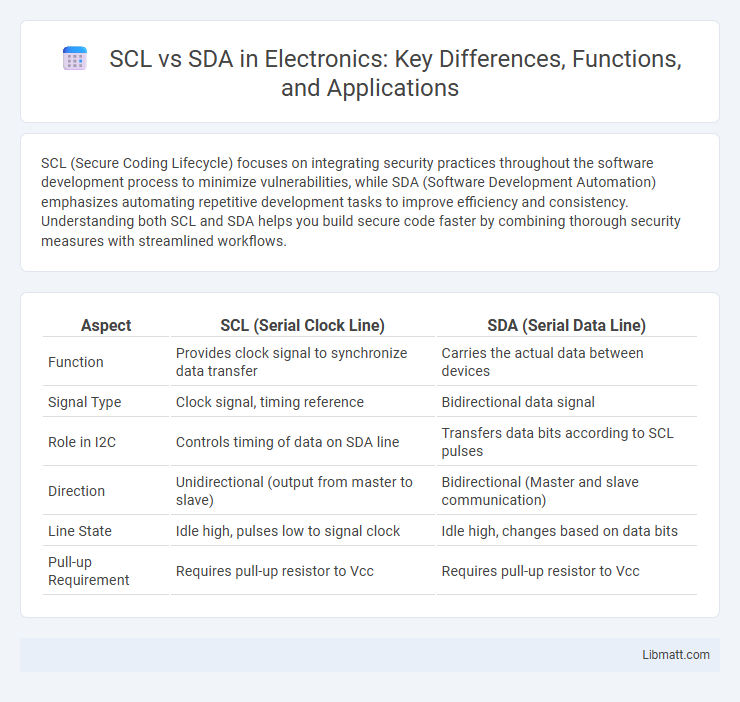SCL (Secure Coding Lifecycle) focuses on integrating security practices throughout the software development process to minimize vulnerabilities, while SDA (Software Development Automation) emphasizes automating repetitive development tasks to improve efficiency and consistency. Understanding both SCL and SDA helps you build secure code faster by combining thorough security measures with streamlined workflows.
Table of Comparison
| Aspect | SCL (Serial Clock Line) | SDA (Serial Data Line) |
|---|---|---|
| Function | Provides clock signal to synchronize data transfer | Carries the actual data between devices |
| Signal Type | Clock signal, timing reference | Bidirectional data signal |
| Role in I2C | Controls timing of data on SDA line | Transfers data bits according to SCL pulses |
| Direction | Unidirectional (output from master to slave) | Bidirectional (Master and slave communication) |
| Line State | Idle high, pulses low to signal clock | Idle high, changes based on data bits |
| Pull-up Requirement | Requires pull-up resistor to Vcc | Requires pull-up resistor to Vcc |
Introduction to SCL and SDA
SCL (System Control Language) is a specialized programming language designed for managing system configurations and automation in mainframe environments, emphasizing precise control over system operations. SDA (Screen Design Aid) is a tool primarily used for creating and modifying user interface screens in IBM mainframe applications, enabling efficient and user-friendly terminal screen design. Both SCL and SDA serve distinct roles in mainframe system administration and application development, with SCL focusing on system-level scripting and SDA optimizing user interface layout.
What is SCL?
SCL (Serial Clock Line) is a fundamental component of the I2C communication protocol, providing the clock signal required to synchronize data transfer between devices. It ensures accurate timing for data exchange by controlling the rate at which bits are transmitted on the SDA (Serial Data Line). Your devices rely on SCL for coordinating communication and maintaining data integrity in multi-device I2C networks.
What is SDA?
SDA, or Serial Data Line, is a crucial communication line in I2C protocols that transmits data between devices in real-time. It works alongside SCL, the Serial Clock Line, which synchronizes data transfer timing, ensuring accurate and reliable data communication. Understanding SDA's role helps optimize your device's data integrity and communication efficiency in embedded systems.
SCL vs SDA: Key Differences
SCL (Serial Clock Line) and SDA (Serial Data Line) are fundamental components of the I2C communication protocol, where SCL synchronizes data transfer by providing the clock signal, while SDA carries the actual data between devices. SCL operates as a timing reference, ensuring that data bits on the SDA line are read or written at precise intervals, which is crucial for reliable communication. Your successful implementation of I2C depends on understanding that SCL controls the timing of signals, whereas SDA is responsible for transmitting the information across the bus.
Importance of SCL and SDA in Communication Protocols
SCL (Serial Clock Line) and SDA (Serial Data Line) are fundamental components in I2C communication protocols, where SCL provides the clock signal that synchronizes data transmission on the SDA line. The accurate timing and coordination between SCL and SDA ensure reliable data exchange between microcontrollers and peripheral devices in embedded systems. Efficient management of these signals is crucial for preventing data collisions and maintaining high-speed communication integrity.
SCL and SDA in I2C Protocol
SCL (Serial Clock Line) and SDA (Serial Data Line) are the two primary signals in the I2C protocol, enabling communication between devices. SCL controls the timing of data transfer, providing the clock pulses, while SDA carries the actual data bits synchronously with SCL. Your devices rely on the precise coordination of SCL and SDA to ensure accurate and efficient data exchange in I2C communications.
Common Applications of SCL and SDA
SCL (Short Circuit Logic) is commonly used in industrial automation systems for safety-related applications and fault diagnosis, ensuring reliable control processes in manufacturing plants. SDA (Semantic Data Annotation) finds extensive application in data integration, enhancing interoperability between diverse datasets in healthcare, finance, and IoT environments. Both SCL and SDA play critical roles in optimizing system performance and data accuracy across various technological domains.
Signal Timing: SCL vs SDA
SCL (Serial Clock Line) controls the clock timing signals in I2C communication, synchronizing data transfer between devices on the bus. SDA (Serial Data Line) carries the actual data bits, with signal transitions aligned to the clock pulses generated by SCL. Precise timing coordination between SCL pulses and SDA data changes ensures reliable data transmission and proper interpretation of each bit in the communication protocol.
Troubleshooting SCL and SDA Issues
Troubleshooting SCL (Serial Clock Line) and SDA (Serial Data Line) issues often involves checking for proper pull-up resistor values and verifying signal integrity using an oscilloscope. Common problems include bus contention, incorrect voltage levels, or timing violations that disrupt I2C communication. Identifying stuck or shorted lines by monitoring voltage transitions can help isolate and resolve SCL and SDA-related faults efficiently.
Summary: Choosing Between SCL and SDA
Selecting between SCL (Sequential Consistency Locking) and SDA (Strong Data Authentication) depends on system requirements for data integrity and concurrency control. SCL is ideal for scenarios needing strict order of operations and preventing race conditions, enhancing consistency in multi-threaded environments. SDA excels in securing data authenticity and tamper resistance, making it suitable for applications demanding robust data verification.
SCL vs SDA Infographic

 libmatt.com
libmatt.com